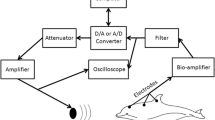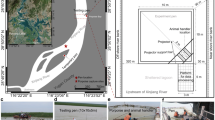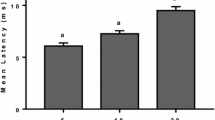Abstract
Temporal cues are important for some forms of auditory processing, such as echolocation. Among odontocetes (toothed whales, dolphins, and porpoises), it has been suggested that porpoises may have temporal processing abilities which differ from other odontocetes because of their relatively narrow auditory filters and longer duration echolocation signals. This study examined auditory temporal resolution in two Yangtze finless porpoises (Neophocaena phocaenoides asiaeorientalis) using auditory evoked potentials (AEPs) to measure: (a) rate following responses and modulation rate transfer function for 100 kHz centered pulse sounds and (b) hearing thresholds and response amplitudes generated by individual pulses of different durations. The animals followed pulses well at modulation rates up to 1,250 Hz, after which response amplitudes declined until extinguished beyond 2,500 Hz. The subjects had significantly better hearing thresholds for longer, narrower-band pulses similar to porpoise echolocation signals compared to brief, broadband sounds resembling dolphin clicks. Results indicate that the Yangtze finless porpoise follows individual acoustic signals at rates similar to other odontocetes tested. Relatively good sensitivity for longer duration, narrow-band signals suggests that finless porpoise hearing is well suited to detect their unique echolocation signals.









Similar content being viewed by others
Abbreviations
- AEP:
-
Auditory evoked potential
- FFT:
-
Fast Fourier transform
- MRTF:
-
Modulation rate transfer function
- pe rms:
-
Peak-equivalent root-mean square
- p-p:
-
Peak-to-peak
References
Akamatsu T, Teilmann J, Miller LA, Tougaard J, Dietz R, Wang D, Wang K, Siebert U, Naito Y (2007) Comparison of echolocation behaviour between coastal and riverine porpoises. Deep Sea Res II 54:290–297. doi:10.1016/j.dsr2.2006.11.006
Au WWL (1993) The sonar of dolphins. Springer, New York
Au WWL, Lemonds DW, Vlachos S, Nachtigall PE, Roitblat HL (2002) Atlantic bottlenose dolphin (Tursiops truncatus) hearing thresholds for brief broadband signals. J Comp Psychol 116:151–157
Au WWL, Moore PWB, Pawloski DA (1988) Detection of complex echoes in noise by an echolocating dolphin. J Acoust Soc Am 83:662–668. doi:10.1121/1.396161
Bullock TH, Grinnell AD, Ikezono F, Kameda K, Katsuki Y, Nomoto M, Sato O, Suga N, Yanagisava K (1968) Electrophysiological studies of the central auditory mechanisms in cetaceans. Z Vergl Physiol 59:117–156
Cook MLH, Verela RA, Goldstein JD, McCulloch SD, Bossart GD, Finneran JJ, Houser DS, Mann DA (2006) Beaked whale auditory evoked potential hearing measurements. J Comp Physiol A 192:489–495. doi:10.1007/s00359-005-0086-1
Finneran JJ, Houser DS (2006) Comparison of in-air evoked potential and underwater behavioral hearing thresholds in four bottlenose dolphins (Tursiops truncatus). J Acoust Soc Am 119:3181–3192. doi:10.1121/1.2180208
Finneran JJ, London HR, Houser DS (2007) Modulation rate transfer functions in bottlenose dolphins (Tursiops truncatus) with normal hearing and high-frequency hearing loss. J Comp Physiol A 193:835–843. doi:10.1007/s00359-007-0238-6
Johnson CS (1966) Auditory thresholds of the bottlenosed porpoise (Tursiops truncatus, Montagu). U.S. Naval Ordnance Test Station, China Lake
Johnson CS (1968) Relation between absolute threshold and duration-of-tone pulses in the bottlenosed porpoise. J Acoust Soc Am 43:757–763. doi:10.1121/1.1910893
Kastelein RA, Bunskoek P, Hagedoorn M, Au WWL, de Haan D (2002) Audiogram of a harbor porpoise (Phocoena phocoena) measured with narrow-band frequency-modulated signals. J Acoust Soc Am 112:334–344. doi:10.1121/1.1480835
Klishin VO, Popov VV, Supin AY (2000) Hearing capabilities of a beluga whale, Delphinapterus leucas. Aquat Mamm 26:212–228
Li S, Wang D, Wang K, Akamatsu T (2006) Sonar gain control in echolocating finless porpoises (Neophocaena phocaenoides) in an open water (L). J Acoust Soc Am 120:1803–1806. doi:10.1121/1.2335674
Li S, Wang K, Wang D, Akamatsu T (2005) Echolocation signals of the free-ranging Yangtze finless porpoise (Neophocaena phocaenoides asiaeorientalis). J Acoust Soc Am 117:3288–3296. doi:10.1121/1.1882945
Madsen PT (2005) Marine mammals and noise: Problems with root mean square sound pressure levels for transients. J Acoust Soc Am 117:3957–3962. doi:10.1121/1.1921508
Madsen PT, Wahlberg M (2007) Recording and quantification of ultrasonic echolocation clicks from free-ranging toothed whales. Deep Sea Res I 54:1421–1444. doi:10.1016/j.dsr.2007.04.020
Mooney TA, Nachtigall PE, Taylor KA, Miller LA, Rasmussen M (2009) Comparative auditory temporal resolution of the white-beaked dolphin (Lagenorhynchus albirostris). J Comp Physiol A 195:375–384. doi:10.1007/s00359-009-0415-x
Mooney TA, Nachtigall PE, Yuen MML (2006) Temporal resolution of the Risso’s dolphin, Grampus griseus, auditory system. J Comp Physiol A 192:373–380. doi:10.1007/s00359-005-0075-4
Moore PWB, Hall RW, Friedl WA, Nachtigall PE (1984) The critical interval in dolphin echlocation: what is it? J Acoust Soc Am 76:314–317
Mulsow J, Reichmuth CJ (2007) Electrophysiological assessment of temporal resolution in pinnipeds. Aquat Mamm 33:122–131
Nachtigall PE, Mooney TA, Taylor KA, Miller LA, Rasmussen M, Akamatsu T, Teilmann J, Linnenschidt M, Vikingsson GA (2008) Shipboard measurements of the hearing of the white-beaked dolphin, Lagenorynchus albirostris. J Exp Biol 211:642–647
Nachtigall PE, Mooney TA, Taylor KA, Yuen MML (2007) Hearing and auditory evoked potential methods applied to odontocete cetaceans. Aquat Mamm 33:6–13. doi:10.1578/AM.33.1.2007.6
Ostroff J, McDonald K, Schneider B, Alain C (2003) Aging and the processing of sound duration in human auditory cortex. Hear Res 181:1–7. doi:10.1016/S0378-5955(03)00113-8
Popov VV, Supin AY (2001) Contribution of various frequency bands to ABR in dolphins. Hear Res 151:250–260. doi:10.1016/S0378-5955(00)00234-3
Popov VV, Supin AY, Klishin VO (1996) Frequency tuning curves of the dolphin’s hearing: envelope-following response study. J Comp Physiol A 178:571–578. doi:10.1007/BF00190187
Popov VV, Supin AY, Wang D, Wang K (2006) Nonconstant quality of auditory filters in the porpoises, Phocoena phocoena, and Neophocaena phocaenoides (Cetacea, Phocoenidae). J Acoust Soc Am 119:3173–3180. doi:10.1121/1.2184290
Popov VV, Supin AY, Wang D, Wang K, Xiao J, Li S (2005) Evoked-potential audiogram of the Yangtze finless porpoise Neophocaena phocaenoides asiaeorientalis (L). J Acoust Soc Am 117:2728–2731. doi:10.1121/1.1880712
Skinner PH, Jones HC (1968) Effects of signal duration and rise time on the auditory evoked potential. J Speech Hear Res 11:301–306
Supin AY, Popov VV (1995) Envelope-following response and modulation rate transfer function in the dolphin’s auditory system. Hear Res 92:38–45. doi:10.1016/0378-5955(95)00194-8
Supin AY, Popov VV, Mass AM (2001) The sensory physiology of aquatic mammals. Kluwer, Boston
Szymanski MD, Supin AY, Bain DE, Henry KR (1998) Killer whale auditory evoked potentials to rhythmic clicks. Mar Mamm Sci 14:676–691. doi:10.1111/j.1748-7692.1998.tb00756.x
Urick RJ (1983) Principles of underwater sound. Mc-Graw-Hill, New York
Vermeister NF (1979) Temporal modulation transfer functions based on modulation thresholds. J Acoust Soc Am 66:1364–1380. doi:10.1121/1.383531
Viemeister NF, Plack CJ (1993) Time analysis. In: Yost WA, Popper AN, Fay RR (eds) Human Psychophysics. Springer, New York, pp 116–154
Yuen MML, Nachtigall PE, Breese M, Supin AY (2005) Behavioral and auditory evoked potential audiograms of a false killer whale (Pseudorca crassidens). J Acoust Soc Am 118:2688–2695. doi:10.1121/1.2010350
Acknowledgments
The authors are grateful to the staff and students at the Baiji Aquarium, Institute of Hydrobiology, for their assistance in data collection and travels in China. We appreciate the advice, encouragement, and support from Alexander Supin, Vladimir Popov, Scott Cramer, Julie Arruda, Maya Yamato and Paul Nachtigall. The comments of two excellent reviewers greatly improved this manuscript. The work was supported by the Office of Naval Research, a WHOI Mellon Joint Initiatives Award, the Chinese National Natural Science Foundation (grant No: 30730018) and the Institute of Hydrobiology of the Chinese Academy of Sciences, and we thank them all for their contribution. The care and use of the animals was performed under China’s Wildlife Protection Act, 1989, Implementation Bylaw on Aquatic Wildlife Conservation, and the Woods Hole Oceanographic Institution’s Animal Care and Utilization Committee (protocol number DRK #3).
Author information
Authors and Affiliations
Corresponding author
Rights and permissions
About this article
Cite this article
Mooney, T.A., Li, S., Ketten, D.R. et al. Auditory temporal resolution and evoked responses to pulsed sounds for the Yangtze finless porpoises (Neophocaena phocaenoides asiaeorientalis). J Comp Physiol A 197, 1149–1158 (2011). https://doi.org/10.1007/s00359-011-0677-y
Received:
Revised:
Accepted:
Published:
Issue Date:
DOI: https://doi.org/10.1007/s00359-011-0677-y




